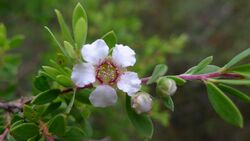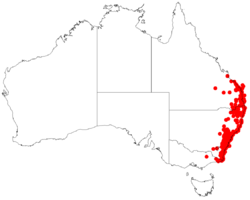Biology:Leptospermum trinervium
| Flaky-barked tea-tree | |
|---|---|

| |
| Leptospermum trinervium in the Royal National Park | |
| Scientific classification | |
| Kingdom: | Plantae |
| Clade: | Tracheophytes |
| Clade: | Angiosperms |
| Clade: | Eudicots |
| Clade: | Rosids |
| Order: | Myrtales |
| Family: | Myrtaceae |
| Genus: | Leptospermum |
| Species: | L. trinervium
|
| Binomial name | |
| Leptospermum trinervium | |

| |
| Occurrence data from AVH | |
| Synonyms[1] | |
|
List
| |
Leptospermum trinervium, commonly known as flaky-barked tea-tree, slender tea-tree[2] or paperbark tree,[3] is a species of shrub or small tree that is endemic to eastern Australia. It has papery bark that is shed in thin, flaking layers, narrow elliptic to broadly egg-shaped leaves with the narrower at the base, white flowers and silky-hairy fruit that falls from the plant when mature.
Description
Leptospermum trinervium is a shrub or small tree that typically grows to a height of 2–6 m (6 ft 7 in–19 ft 8 in) and has papery bark that is shed in thin, flaking strips. The leaves are narrow elliptical to broadly egg-shaped with the narrower end towards the base, 9–22 mm (0.35–0.87 in) long and 1–6 mm (0.039–0.236 in) wide, the tip usually blunt and the base tapering to a short petiole. The flowers are white, about 7–15 mm (0.28–0.59 in) wide and arranged singly or in pairs on the ends of short side shoots. The floral cup is densely covered with silky hairs, about 3 mm (0.12 in) long tapering to a pedicel of variable length. The sepals are also hairy, oblong to triangular, about 1.5–2.5 mm (0.059–0.098 in) long, the five petals 5–7 mm (0.20–0.28 in) long and the stamens 1.5–2 mm (0.059–0.079 in) long. Flowering mostly occurs from September to October near the coast and from November to December on the tablelands. The fruit is a capsule 3–6 mm (0.12–0.24 in) wide with the remains of the sepals attached and that falls the plant at maturity.[2][3][4]
Taxonomy
This tea-tree was first described in 1790 by James Edward Smith who gave it the name Melaleuca ? trinervia and published the description in John White's Journal of a Voyage to New South Wales.[5][6]
Distribution and habitat
Flaky-barked tea-tree mainly grows in forest but is also found in heath and scrub, especially among sandstone rocks. It occurs on the coast and tablelands south from Rockhampton in Queensland through eastern New South Wales to near coastal scrubland and woodland in far eastern Victoria.[2][3][4]
Use in horticulture
Leptospermum trinervium is a hardy, although not showy plant, the bark being its most unusual feature. It can be propagated from seed or from cuttings and is frost hardy.[7]
References
- ↑ 1.0 1.1 "Leptospermum trinervium". Australian Plant Census. https://biodiversity.org.au/nsl/services/apc-format/display/101750. Retrieved 13 June 2020.
- ↑ 2.0 2.1 2.2 "Leptospermum trinervium". Royal Botanic Garden Sydney. http://plantnet.rbgsyd.nsw.gov.au/cgi-bin/NSWfl.pl?page=nswfl&lvl=sp&name=Leptospermum~trinervium. Retrieved 13 June 2020.
- ↑ 3.0 3.1 3.2 "Leptospermum trinervium". Royal Botanic Gardens Victoria. https://vicflora.rbg.vic.gov.au/flora/taxon/dc80ce75-481a-4971-b026-7b57d64cf91a. Retrieved 13 June 2020.
- ↑ 4.0 4.1 Thompson, Joy (1989). "A revision of the genus Leptospermum (Myrtaceae)". Telopea 3 (3): 366–368.
- ↑ "Leptospermum trinervium". APNI. https://id.biodiversity.org.au/instance/apni/545289. Retrieved 13 June 2020.
- ↑ Smith, James Edward (1790). Journal of a Voyage to New South Wales. London: John Debrett. p. 229. https://www.biodiversitylibrary.org/item/181420#page/299/mode/1up. Retrieved 13 June 2020.
- ↑ "Leptospermum trinervium". Australian National Botanic Gardens. http://www.cpbr.gov.au/leptospermum/leptospermum-trinervium.html. Retrieved 14 June 2020.
Wikidata ☰ Q4460550 entry
 |

